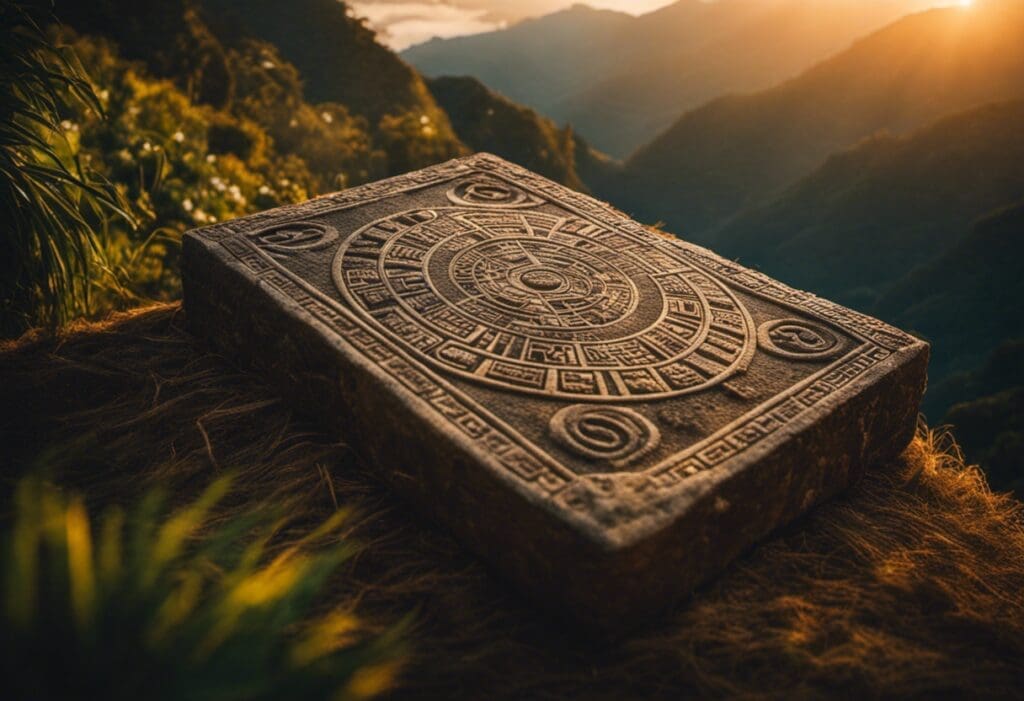In the ancient civilization of the Incas, the concept of time was intricately woven into every aspect of life, including agriculture.
The Inca calendar, a remarkable tool of celestial observation and mathematical precision, played a crucial role in guiding their farming practices.
By aligning planting seasons, crop rotation, and water management with the movements of the stars and the cycles of nature, the Inca calendar provided invaluable insights that maximized harvests and ensured food security.
This article explores the profound influence of the Inca calendar on agricultural planning and productivity.
Key Takeaways
- The Inca calendar played a crucial role in predicting seasons and weather patterns, guiding agricultural activities such as planting and harvesting.
- Crop rotation was an important practice in Inca agriculture, and the Inca calendar determined the optimal timing for rotation, preventing soil depletion and increasing yields.
- The Inca calendar helped the Incas plan for climate variations by providing insights into changing weather patterns, allowing them to implement irrigation systems and select drought-resistant crops.
- Celestial events such as solstices and equinoxes influenced planting seasons and guided planting techniques based on celestial observations, ensuring successful crop growth.
The Inca Calendar: A Tool for Agricultural Planning


The Inca calendar plays a crucial role in agricultural planning for the Incas. The Incas were highly skilled astronomers and observed celestial events to determine the timing of agricultural activities. Their calendar was based on the movements of the sun, moon, and stars, which helped them predict seasons and weather patterns. By closely monitoring these celestial events, the Incas were able to plan their agricultural activities, such as planting and harvesting, with great precision.
One of the key factors taken into account in the Inca calendar was crop rotation. The Incas practiced a sophisticated system of crop rotation to maximize the fertility of their fields. Different crops were grown in different areas each year to prevent soil depletion and increase yields. The Inca calendar played a vital role in determining when to rotate crops. By aligning the timing of crop rotation with celestial events, such as the solstices and equinoxes, the Incas ensured that each crop received the optimal amount of sunlight and rainfall.
Furthermore, the Inca calendar also helped the Incas plan for potential climate variations. By observing celestial events, they could anticipate changes in weather patterns and adjust their agricultural practices accordingly. For example, if a celestial event indicated that a drought was likely, the Incas could prepare by implementing irrigation systems or selecting drought-resistant crops. This level of foresight and adaptability made the Inca calendar an invaluable tool for agricultural planning, ensuring the success and sustainability of their farming practices.
Celestial Events and Planting Seasons in the Inca Calendar


One of the key celestial events observed in the Inca calendar were the solstices, which marked the beginning of the planting seasons. The Inca people understood the importance of celestial events in determining the most favorable times for agricultural activities. They believed that the position of the sun, moon, and stars influenced the growth and productivity of crops.
The Inca calendar incorporated various celestial events and astronomical observations to guide their planting techniques. They carefully observed the movement of the sun and its alignment with specific landmarks to determine the optimal time for planting. For example, during the winter solstice, which usually falls around June 21st in the Southern Hemisphere, the Inca would perform agricultural rituals to ensure a successful planting season. They believed that by aligning their actions with the celestial events, they would receive blessings from the gods and ensure bountiful harvests.
The Inca calendar also included other important celestial events such as equinoxes and lunar cycles. These events provided valuable information about the changing seasons and the appropriate timing for planting and harvesting. By closely monitoring these celestial events, the Inca were able to synchronize their agricultural activities with the natural rhythms of the environment, maximizing their chances of successful crop cultivation.
Maximizing Harvests: The Inca Calendar’s Crop Rotation System


Maximizing agricultural yields, the Inca calendar implemented a sophisticated crop rotation system that ensured sustainable cultivation practices and optimized harvests. This system was based on the understanding that planting the same crop repeatedly in the same field depletes the soil of specific nutrients, leading to decreased yields over time. By rotating crops, the Inca were able to maintain soil fertility and promote crop diversity, resulting in higher yields and reduced risk of crop failure.
The Inca crop rotation system was characterized by the following practices:
-
Crop sequencing: Different crops were planted in a specific order, ensuring that each field received a variety of crops over time. For instance, legumes were often followed by grains, which helped replenish nitrogen in the soil.
-
Terracing: The Inca created terraces on the steep slopes of the Andes to create flat land for cultivation. These terraces were used for different crops, allowing for efficient rotation and preventing soil erosion.
-
Intercropping: The Inca practiced intercropping, where different crops were grown together in the same field. This technique not only maximized land use but also prevented the spread of pests and diseases.
-
Fallowing: To further promote soil fertility, the Inca practiced fallowing, which involved leaving a field uncultivated for a period of time. During this period, the land could regenerate and regain its nutrients.
The Inca Calendar’s Influence on Irrigation and Water Management


Through its intricate understanding of celestial movements, the Inca calendar played a vital role in guiding the irrigation and water management systems of the empire. The Incas developed advanced irrigation techniques that were essential for sustaining their agricultural practices and ensuring long-term agricultural sustainability.
One of the main irrigation techniques used by the Incas was the construction of canals and terraces. They built an extensive network of canals to divert water from rivers and streams to their fields. These canals were carefully designed to distribute water efficiently and evenly across the agricultural lands. In addition, the Incas built terraces on steep slopes to prevent soil erosion and facilitate water retention. These terraces acted as retaining walls, allowing water to slowly seep into the soil and preventing it from running off the fields.
The Inca calendar played a crucial role in determining the timing and duration of irrigation activities. By observing the movement of celestial bodies, the Incas were able to predict the rainy seasons and plan their irrigation schedules accordingly. They knew when to start and stop irrigating their fields to maximize water usage and minimize water wastage. This knowledge allowed them to adapt to the fluctuating water availability and ensure the efficient use of this precious resource.
The Inca Calendar’s Role in Predicting Weather Patterns for Agriculture


The Inca calendar’s meticulous observations of celestial phenomena allowed for accurate predictions of weather patterns, providing invaluable insights for agricultural planning and productivity. The Incas recognized the interconnectedness between celestial events and weather patterns, and they used their calendar system to track these correlations.
Here are four ways in which the Inca calendar played a vital role in predicting weather patterns for agricultural planning:
-
Seasonal Changes: By closely monitoring the movement of celestial bodies, such as the sun and stars, the Incas could identify the changing seasons. This knowledge helped them determine the optimal time for planting and harvesting crops.
-
Rainfall Patterns: The Inca calendar also helped predict rainfall patterns. The Incas observed the movement of clouds and the appearance of specific constellations to anticipate periods of heavy rain or drought. This information allowed them to plan irrigation systems and adjust their agricultural practices accordingly.
-
El Niño Events: The Inca calendar provided insights into the occurrence of El Niño events, which are characterized by abnormal weather patterns. By monitoring changes in ocean temperatures and atmospheric conditions, the Incas could predict the arrival of El Niño and adapt their agricultural strategies to mitigate its impact.
-
Extreme Weather Events: The Inca calendar helped the Incas anticipate extreme weather events such as storms, frosts, and heatwaves. This advanced warning allowed them to protect their crops and livestock, reducing potential losses and ensuring food security.
The Inca calendar’s ability to predict weather patterns was a testament to the Incas’ deep understanding of celestial phenomena and their astute agricultural planning. These predictions allowed them to optimize their agricultural practices and ensure the success of their crops, contributing to the prosperity of their civilization.
Conclusion
In conclusion, the Inca calendar played a crucial role in the agricultural practices of the Inca civilization. By aligning celestial events with planting seasons, the calendar allowed for effective agricultural planning.
Additionally, the calendar’s crop rotation system maximized harvests and contributed to sustainable farming practices.
Furthermore, the calendar’s influence on irrigation and water management ensured the availability of water for crops.
Lastly, the calendar’s ability to predict weather patterns provided valuable insights for agricultural activities.
Thus, the Inca calendar’s multifaceted role in agriculture highlights its significance in the success of the Inca civilization.




